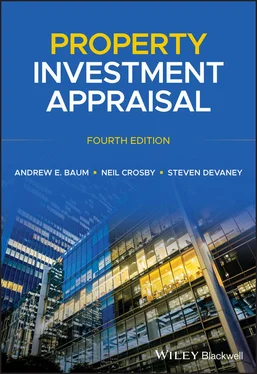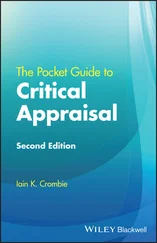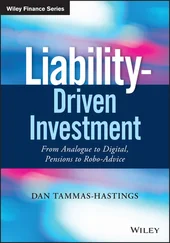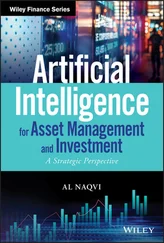Source: Constructed by the authors from MSCI Global Intel 2020.
MSCI has, for several years, compiled transaction-based indices for some national markets (MSCI 2013), and comparisons with valuation-based indices for the same markets provide some varied results. The last set of comparisons that are available for a wide range of markets covers the period 2002–2019 (MSCI 2013). The results are set out in Figure 1.2. Some countries over this period had volatile property markets, like Switzerland, Italy, and Sweden, with standard deviations of 7.1%, 5.2%, and 4.8% per quarter, respectively. Others, such as the Netherlands, France, and Germany, were much more stable with standard deviations of 2.6%, 3.2%, and 3.8% per quarter, respectively. The more interesting differences are between the valuation and transaction-based series for each country. In the UK, the standard deviation for changes in the transaction index is only a bit above that for the valuation index, at 4.6% and 3.2% per quarter, respectively. At the other extreme, the valuation-based indices in Switzerland, Italy, and Germany have very low standard deviations at 0.2%, 0.6%, and 0.8% despite, in the case of Switzerland and Italy, having the highest volatility of transaction-based returns.
These results raise issues and concerns. Despite the basis of market valuation across the globe within international, regional, and national valuation standards being broadly agreed, valuations in some European markets may not follow prices as closely as others.
1.3.2 Client Influence on Valuations
Research has shown that valuers and valuations can consciously or sub-consciously be affected by a variety of factors ranging from previous valuations and new information to the influence of clients and other stakeholders in the valuation outcome. The major focus for research on client and stakeholder influence has been in two areas, specifically bank lending valuations and performance measurement valuations. Individual loans are secured on property valuations and investor benchmarking is mainly valuation-based.
Performance measurement valuations are undertaken for a wide variety of property owners including pension funds, insurance companies, property companies, REITS (real estate investment trusts), open-ended funds, and closed-end funds. Although in most countries these valuations will be undertaken by third-party service providers, asset managers are often involved in the process. Major bank loans are often brokered, and the valuer may be known to the broker, borrower, and lender. In the UK, the client is the lender, but in some countries the client can be the borrower. The literature discusses numerous different motivations for clients or other stakeholders to try and encourage the valuer to either increase or decrease valuations in these situations. Articles on client influence are numerous (see Crosby et al. 2010, 2018a, for reviews) and this literature has raised the following issues related to individual clients, borrowers, lenders, and asset managers.
In the case of performance measurement, valuations can have a dual purpose. For example, Property Company and REIT valuations are used for financial statements and the company's Net Asset Value will have an impact on the share price, in which case the directors may have an interest in keeping the valuations as high as possible. Managers may also be remunerated on the basis of the performance of the fund, a practice that has come under scrutiny in the wake of the Global Financial Crisis, but remains widespread. Carried interest payments will usually kick in when assets are sold, but might be valuation based. In such cases, persuading valuers to adjust valuations by small amounts could tip the balance over the payment of bonuses.
In contrast, other owners or managers might want valuations to be low. For example, a new fund manager might want the lowest possible start point from which their future performance is to be assessed, while a fund manager wanting to sell an asset might want a valuation to be low to make any subsequent offer look good to the investment committee. Open-ended funds may want valuations to fall as much as possible in a downturn in order to prevent large volumes of units being sold at excessive prices. (Units in such funds are priced by reference to the level of valuations and a run might occur where unit holders think that valuations overstate the actual value of the underlying assets.) Crosby et al. (2018a) use data measuring MSCI UK capital value changes through the GFC period, and found differences between the performance of open-ended funds and that of property companies/REITs which are consistent with the ideas noted above.
In the case of bank lending, a borrower may need a valuation of a minimum amount so that the loan to value ratio will not prevent them from borrowing the amount that they desire. The broker will not want the valuation to kill the deal and the employee of the bank may be rewarded by a bonus that is only paid when a loan is made. Motivation for client influence is not, therefore, in doubt. A number of experimental studies and surveys have shown that the valuation process allows clients and stakeholders access to the valuer. They have also identified a number of ways in which a valuer can be pressured, but there is no evidence of systematic bias in the process caused by client influence. Nonetheless, the RICS now includes protocols for behaviour at draft valuation meetings within the Red Book (RICS 2020a, PS 2).
1.4 Conventional and Discounted-Cash-Flow Approaches to Appraisal
The aftermath of the real estate downturn in the early 1990s sparked a huge interest in valuation techniques. Despite continuing interest in the valuation process, the GFC does not appear to have had the same effect. This is partly because the 2007 crash was a global asset/financial market crash and not an occupier-driven crash, as was the case in the 1990s. As we will demonstrate, conventional valuation methods become very troublesome when the current rental income is no longer to be relied upon as a good indicator of future cash flows. Nonetheless, the GFC did lead to a search for a more appropriate valuation basis and method for assessing property values for bank lending purposes, as reflected in Chapter 10, which has been added to this edition. After the GFC, more interest also developed around issues such as bank lending covenants (e.g. loan to value ratios), comparative valuations in markets where transactions were sparse, and the valuation of open-ended funds.
In contrast, the early 1990s occupier market crash led directly to an increased interest in valuation techniques from UK clients and valuers, and from those whose role it is to comment on valuation practice. This process had started at the time of writing the second edition of this text in 1994/1995, but, despite the criticism of conventional valuation techniques contained in that edition and in other works that followed over the next 10 years, conventional approaches still dominated the UK market valuation practice in the pre-GFC period in which the third edition was produced. This was in increasing contrast to some other mature real estate markets in which discounted-cash-flow (DCF) valuations dominated (for example, Sweden). Despite the GFC, nothing seems to have changed in this regard and UK market valuation by conventional techniques, set out and critiqued from Chapter 4onwards, still dominates practice, albeit often checked by DCF-based Investment Valuations.
Why is the UK more wedded to comparative conventional techniques than some other markets? Despite some high-rise development and the increasing importance of multi-let large-scale shopping centres, the UK still has much – albeit a decreasing amount of - prime property investment stock let on long leases to single occupiers. The typical institutional UK lease was traditionally the longest in the world and, despite major changes since 1990 (see Crosby et al. 2005 and the annual UK lease review produced by MSCI), has had the added benefit of upward-only rent reviews and ‘triple net’ rents. This has produced simple, low-risk investments with limited variability of cash flow. In these circumstances, the initial rent can explain a large proportion of the value of the asset and so the development of a comparative valuation method based on capitalising the initial rent can be understood. Given these physical and leasing characteristics, it is no great surprise that UK valuations persist in adopting simple comparison-based valuation methods rather than DCF-based approaches to appraisal. This is increasingly dangerous; the unsustainability of retail rents is a clear example, set in sharp focus by the COVID-19 crisis. To repeat ourselves: conventional valuation methods become very troublesome when the current rental income is no longer to be relied upon as a good indicator of future cash flows.
Читать дальше












